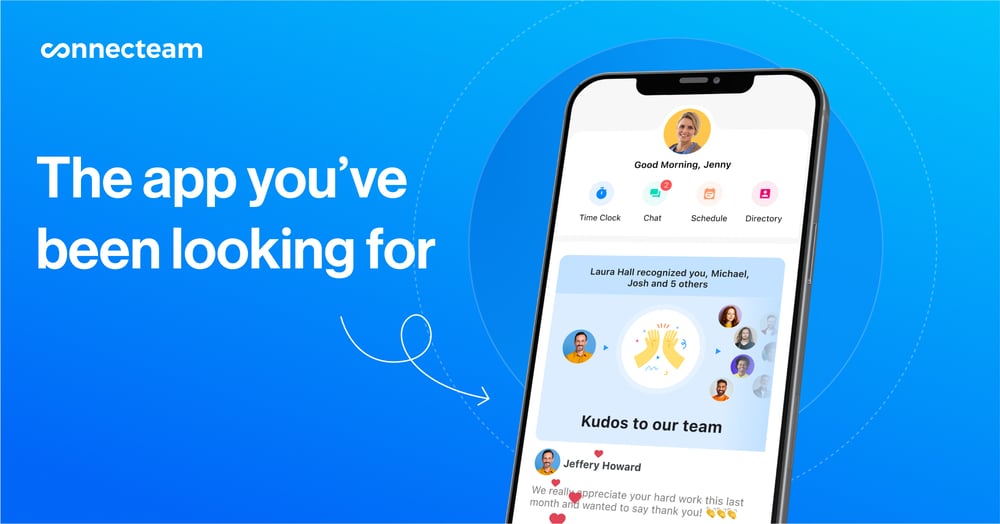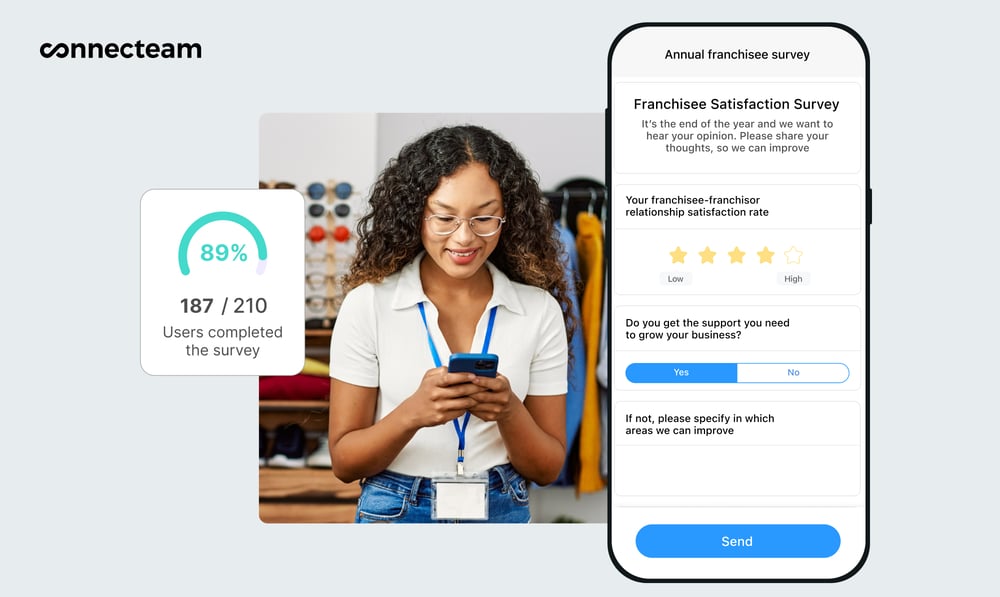An employee retention survey can help you better understand your employees’ opinions and needs so you can prevent turnover. Below, we share 35 employee retention survey questions and tips for implementing your survey successfully.
Turnover is a frustrating problem that affects you and your team members alike. When workers leave your business, you face a drop in productivity and decreased employee morale. It’s also costly and time-consuming to recruit and hire new talent to replace employees who have left.
The good news? There are steps you can take to reduce turnover at your company. And you can start by listening to a group you already have direct access to: your employees.
Employee retention surveys can help you find out what your workers truly want so you can meet their needs and keep more of them around for the long term.
In this article, we cover the ins and outs of employee retention surveys, why you need to conduct them regularly, how to do it, and the most important questions to ask.
Key Takeaways
- Employee retention surveys can be used to assess your current workforce’s satisfaction levels and the likelihood of them leaving your organization.
- When designing your survey, think about the most common reasons for turnover (like compensation dissatisfaction and lack of engagement) to determine the right questions to ask.
- The information you learn from your employee retention surveys can help you make positive changes at work. This will improve retention and create a loyal and happy workforce.
What Is an Employee Retention Survey?
An employee retention survey is a questionnaire that goes out to employees to gain their honest feedback about their roles and the workplace. These surveys are an important way for an organization to gauge employee sentiment and the likelihood workers will stay on the team.
These surveys will typically ask employees questions related to:
- Job satisfaction
- Compensation and benefits
- Communication and feedback
- Work-life balance
- Professional development opportunities
- Management
- Rewards and recognition
The insight your employees provide on these subjects can help you understand which of their needs aren’t being met. This way, you can make meaningful changes that will make employees feel more valued and better equipped to do their jobs.
In turn, employees are more likely to feel engaged with their work and your organization as a whole, decreasing the chances that they’ll quit.
Why Use an Employee Retention Survey?
Prevent turnover
Of course, one of the two biggest reasons to implement retention surveys is to prevent employee turnover at your company.
More than half of employees say their employers could have prevented them from leaving. This means employee turnover is a preventable problem. Using an employee retention survey can help you get ahead of the problem, saving you the time and money of having to hire new employees down the road.
Increase retention
When turnover rates go down, retention rates go up. And increasing retention is the other main reason to use these surveys.
Employee retention can be defined as the rate your employees stay with you over a period of time and the strategies you’ve set up to keep them there. Employee retention surveys are a key part of a strong retention strategy.
A good retention rate is about 90% and comes with benefits of its own. These include:
- Lower hiring and training costs
- Stronger company culture
- Improved employer brand and reputation
- Increased revenue
- Higher customer satisfaction
- Improved productivity
- Better team collaboration and morale
- Retained knowledge and expertise
This Might Interest You
Find out how to calculate your retention rate and steps you can take to improve it.
Measure and boost employee engagement
According to Gallup research, engaged employees are less likely to quit their jobs and are more productive than non-engaged employees. However, almost 80% of employees worldwide aren’t engaged or are actively disengaged at work.
Employee retention surveys serve as a pulse check on your workforce and can help you measure employee engagement and improve performance.
Identify areas for improvement in your business
The only way you can truly know what needs improvement in your business is by asking those who work for you. Your employees probably experience challenges that you’re currently unaware of. They also often have a more direct relationship with customers and awareness of inefficiencies in day-to-day operations.
Employee retention surveys help you identify what’s working and what’s not in your business so that you can improve your employees’ lives, while growing your business at a faster rate.
Show employees you care
Employee retention surveys can be a powerful way to signal to employees you care about them and are committed to hearing them out in a systematic way.
Plus, when everyone on the team feels like their voice is heard, morale improves and conflict decreases. This allows everyone to be more productive, collaborate more efficiently, and enjoy a more positive work environment.

Create a culture of communication
These surveys can also help you create a culture of open communication at your organization. They help you provide employees with a place they can share their honest opinions and concerns, which fosters open communication between workers and management. This then improves transparency and trust at your company.
Better understand how your company compares to others in the industry
To retain your employees and stay competitive in your industry, it’s good to know how your business stacks up in key areas like:
- HR and hiring procedures
- Onboarding and training
- Employee benefits and incentives
- Professional development investments
- Overall job satisfaction
You can compare your employee retention survey results to industry standards to see where you stand. This can help you increase your competitive edge when it comes to hiring and retaining top talent and creating a better work experience for your team.
Employee Retention Survey Best Practices
Creating and implementing an employee retention survey takes time and effort. The following best practices can help you get maximum participation and better results.
Set a clear objective
Before you can create your survey, you need to think about your goals and set an objective. What are you hoping to gain from the survey? What are you most curious about when it comes to your employees?
For example, perhaps you want to understand what’s impacting employee engagement at your company. Or maybe you want to know how your workers feel about members of management.
Your objective will inform the questions that you ask and ensure you get meaningful, actionable results from your survey.
Communicate with your employees
Ensure employees understand why you’re asking them to complete the survey. For instance, you can note that the purpose of the survey is to give employees an opportunity to share their honest thoughts about their jobs and the workplace in general.
You should also tell them when they need to complete it. Give them a reasonable deadline, such as 1-2 weeks, and plenty of reminders via email, instant message, phone call, etc.
Remember to be patient when implementing a survey, especially for the first time. You might have to try a few times before you get the participation you want. Keep communicating and give your employees time to get used to the process. Ensure they know how important their contribution is and how the information they provide will help you make the workplace better.
Pro Tip
Your employees may feel less comfortable giving you feedback if they’re worried about retaliation from management. Make surveys anonymous to encourage more honest answers and higher participation rates.
Make surveys easy to complete
You want to make it as easy as possible for employees to participate in your retention survey. Try to keep your survey short—around 10-15 questions—and tailored to what you want to know.
Also, make your survey mobile-friendly with an employee communication app like Connecteam. This way, employees can complete the survey on the go, from wherever they are. An app can also send regular reminders to employees to ensure you get more participation.

Conduct surveys regularly
Help employees get accustomed to retention surveys by launching them on a consistent basis—like once every quarter or a couple times per year. Consider adding a retention survey when you do quarterly performance reviews or annual engagement surveys.
Conducting surveys regularly will help you stay consistent and maximize your results. It will also signify to employees that you’re committed to hearing their feedback and making positive changes.
Ask the right questions
Finally, the right employee retention survey questions are essential if you want to get results you can use. Gather both qualitative and quantitative data by including several question types in your survey.
Quantitative data is numerical data, and you can gather it by incorporating rating scale questions that ask employees to offer a score from 1-5 or 1-10. Qualitative data is non-numerical data that captures more nuance. Gather this through open-ended, yes/no, and multiple-choice questions.
Additionally, try not to make any assumptions about how your employees feel and avoid leading questions. For example, “What challenges do you have with your teammates?” assumes that an employee has problems with their coworkers. A better way to phrase this is, “Tell me about the relationship you have with your teammates.”
Of course, since employee retention surveys help you combat employee turnover, it can also be helpful to think of the common reasons for turnover and ask questions related to that.
35 Employee Retention Survey Questions
Below, we outline the best retention survey questions to ask—broken down into the most common reasons employees quit.
Benefits and compensation questions
Nearly 70% of employees are dissatisfied with their current pay, and 61% of employees say they’re interested in benefits their employer doesn’t currently offer.
Asking your employees directly how they feel about their pay and benefits can help you determine whether you’re hitting the mark or if it’s time to get more competitive with your offerings.
Questions to ask
- To what extent are you satisfied with your current compensation?
- 5 – Very satisfied
- 4 – Satisfied
- 3 – Neutral
- 2 – Dissatisfied
- 1 – Very dissatisfied
- Do you feel that you’re paid fairly for your work?
- Yes
- No
- To what extent are you satisfied with your employee benefits?
- 5 – Very satisfied
- 4 – Satisfied
- 3 – Neutral
- 2 – Dissatisfied
- 1 – Very dissatisfied
- What benefits would you like to see that currently aren’t offered?
- To what extent are you satisfied with the company’s paid time off policy?
- 5 – Very satisfied
- 4 – Satisfied
- 3 – Neutral
- 2 – Dissatisfied
- 1 – Very dissatisfied
- On a scale of 1-10, rate each of our benefits in terms of importance to you. [Insert list of benefits]
- On a scale of 1-10, rate these potential new benefits in terms of importance to you. [insert potential new benefits]
Overall job satisfaction questions
When surveying employees about their job satisfaction, you’re looking for a glimpse into the day-to-day details of their current role.
It’s up to you to ensure employees have what they need to be successful—including support from leadership, a manageable workload, and more. The following questions can help you get a sense of how your employees feel about their jobs overall.
Questions to ask
- To what extent are you satisfied with your current job?
- 5 – Very satisfied
- 4 – Satisfied
- 3 – Neutral
- 2 – Dissatisfied
- 1 – Very dissatisfied
- Do you plan on working here a year from now?
- Yes
- No
- Do you have the resources you need to be successful in your role?
- Yes
- No
- How likely are you to recommend working here to a friend?
- Very likely
- Likely
- Neutral
- Unlikely
- Very unlikely
- How strongly do you agree with the following statement? “The reality of my role aligns with the expectations I had for it at the beginning.”
- Strongly agree
- Agree
- Neutral
- Disagree
- Strongly disagree
Employee engagement questions
Though the concepts are similar, employee engagement isn’t the same as employee satisfaction. Employee engagement refers to how connected your employees are to their work and their motivation to get it done. It also refers to how committed they feel to your company.
Employee retention surveys can help measure employee engagement and give you some ideas about what employees need to be more engaged.
Questions to ask
- To what extent do you agree with the following statement? “I feel like I can be myself around managers and teammates.”
- Strongly agree
- Agree
- Neutral
- Disagree
- Strongly disagree
- Do you feel you’re properly recognized for your efforts and accomplishments?
- Yes (and explain why)
- No (and explain why)
- When was the last time you felt proud about something you achieved at work?
- Do you have any goals at work that you’re excited about? If so, what are they? If not, can you explain why not?
- Yes (and explain)
- No (and explain)
- To what extent do you agree to the following statement? “I understand the company’s vision and how I contribute to it.”
- Strongly agree
- Agree
- Neutral
- Disagree
- Strongly disagree
Management questions
Strong leadership and management make a big impact on how happy your employees are at work and are often motivating factors when employees leave a job.
Including some questions about management in your employee retention survey can help you determine how well managers at your organization are actually doing and how your employees feel about them.
Questions to ask
- When leadership makes decisions, do you understand why?
- Yes
- No
- Do you feel the feedback you receive from your manager is helpful? Why or why not?
- Yes (and explain why)
- No (and explain why)
- Do you feel your manager(s) accepts and acts on the feedback you give them?
- Yes
- No
- Do you feel managers handle disagreements professionally?
- Yes (and explain why)
- No (and explain why)
- To what extent do you agree with the following statement? “My manager effectively communicates the information I need to understand.”
- Strongly agree
- Agree
- Neutral
- Disagree
- Strongly disagree
- To what extent do you agree with the following statement? “My manager cares about me as a person.”
- Strongly agree
- Agree
- Neutral
- Disagree
- Strongly disagree
- When was the last time you received recognition from your manager?
Professional development questions
One of the most common reasons employees quit is due to a lack of professional development opportunities. Workers value opportunities for growth and want to understand their trajectory at your company. Those who don’t see any path for growth are more likely to seek out new opportunities.
Use questions like the ones below to gauge your professional development initiatives and see where you can improve.
Questions to ask
- Do you see a clear path for growth at this company?
- Yes
- No
- Do you feel there are adequate professional development opportunities available at this company?
- Yes
- No
- How well does your role align with your career goals?
- Do you feel you’re supported in meeting your career goals? Why or why not?
- Yes (and explain why)
- No (and explain why)
- To what extent are you satisfied with current training and development programs at the company?
- 5 – Very satisfied
- 4 – Satisfied
- 3 – Neutral
- 2 – Dissatisfied
- 1 – Very dissatisfied
This Might Interest You
Learn how you can create effective employee development when working with limited resources and a low budget.
Company culture questions
Company culture is one of the main reasons employees stay in their jobs, according to a Glassdoor survey. The survey also found that a change in company culture would push 71% of workers to seek new employment.
Including some questions about company culture in your survey can help you pinpoint weak spots and uncover biases you might not be aware of.
Questions to ask
- What changes would you make at this organization if given the opportunity?
- On a scale of 1-10, how aligned do you feel you are with the organization’s mission and values?
- Do you feel respected at work? Why or why not?
- Yes (and explain why)
- No (and explain why not)
- How would you describe the company’s culture?
- Do you feel the company’s values are in line with the reality of the work culture?
- Yes
- No
- What measures do you think the company should take to improve cultural diversity?
How to Use Your Employee Retention Survey Data
You’ve designed your survey, asked the right questions, and gathered feedback. Now it’s time to use your data to make positive changes in your organization.
Let’s go over some next steps that can help you put your data to good use and improve retention.
Analyze your data and identify common themes
As your data starts rolling in, the work of combing through the answers begins. Analyze your data and determine what it’s telling you. Are several employees feeling burned out and overwhelmed? Are workers dissatisfied with the company culture?
Look for common responses when identifying areas for improvement. For example, you may not have a reason to make any changes if only 1 employee said they were unhappy with the health benefits you offer. However, it may be time to evaluate your benefits package if multiple employees expressed dissatisfaction with your current offerings.
Depending on the size of your team, you might also benefit from breaking the data down further and segmenting it based on certain characteristics. For example, you could organize your answers by department or the length of time employees have been with the company.
Some groups may have different challenges than others because of the nature of their role or management in that role. Breaking your data down can help you create unique initiatives to address department-specific issues or frustrations that only certain groups of employees have expressed.
Share what you’ve learned with your leadership team
Once you’ve analyzed your data, share your findings with your leadership team. Let other decision-makers in the company know where the biggest issues are and give them time to reflect on these concerns.
Make a plan of action
The next step is to organize a meeting with your leadership team. Together, you can brainstorm creative solutions to meet your employees’ needs.
You may have been given a lot of feedback or identified numerous areas for improvement. In that case, prioritize and target areas where improvement is needed the most.
Pro Tip
At this point, you may consider asking for additional feedback from a few employees to get a better understanding of what their idea of improvement looks like.
For instance, perhaps you find that your company needs to improve the amount and quality of employee professional development opportunities. Your plan of action might be to work with human resource (HR) staff and senior managers to create a mentorship program. You can set specific goals for this plan, such as creating the program within 12 weeks and launching it with 10 pairs of mentors and mentees.
Or, maybe survey results showed you that employees are feeling underappreciated. You might plan to create a new policy where managers select an employee of the month from each of their teams.
Some larger improvements may need to be implemented step by step. Begin by outlining what those steps look like and a reasonable timeline for getting them done.
Communicate with your employees
Employee retention surveys are a great way to empower employees and show them you care about their needs. Giving them an outlet to voice their concerns goes a long way, but it’s also important to show them you plan to act on their feedback.
Consider multiple communication channels to let your employees know how you’re addressing their concerns. You might share the big themes from your survey via email, then go into more detail during an in-person or virtual meeting.
Even if you can’t give them exactly what they’re asking for at the moment, take a transparent approach and explain why. Tell them what your roadblocks are with resolving certain issues (budget, bandwidth, etc.), and ensure they know they’ve been heard and that you’re working on it.
Educate your managers and supervisors
It’s important that managers at your company understand what issues are causing your employees to leave. Your managers are often in the best position to implement change at the ground level, so you’ll want to ensure they’re an integral part of the process and that they have a clear understanding of the biggest issues.
Sometimes, managers themselves are part of employees’ concerns. You can broach this with managers without pointing fingers and use it as a coaching opportunity.
For example, let’s say many of your survey respondents called out a shift leader that never provided them with recognition. These employees feel like their contributions aren’t valued and their motivation at work is quickly dropping off.
Approach the manager one-on-one, and explain the situation to them fully. Describe the comments you received in your survey and the impact the lack of recognition is having on your employees.
Keep an open mind and listen. See if you can get to the root of the issue. In this example, it’s possible that the manager is shy about giving feedback or unsure of the proper ways to recognize employees. You might provide them with some ideas for employee recognition, and challenge them to acknowledge at least 1 member of their team each day.
Take action
In addition to keeping your employees informed and educating managers about their needs, you’ll have to implement the plan of action you’ve put into place. Roll out the programs and policies that you’ve decided on, and continue to communicate at every level.
Designate leaders and supervisors that will be responsible for maintaining momentum on these initiatives and checking progress against your goals.
Repeat the process and monitor results
Employee retention surveys need to be a regular part of your retention strategy in order to be effective.
You can repeatedly measure employees’ satisfaction, engagement, overall feelings about your company, and likelihood of quitting—thus helping you stay on top of turnover.
Conducting regular surveys also enables you to monitor whether your retention initiatives are actually working for your employees. You can compare the results of previous surveys and track changes in sentiment over time. Then, you can reevaluate your strategy as needed and adjust as new problems arise.
Pro Tip
Implement exit surveys—questionnaires sent to employees who are leaving your company. The data you get from these can be extremely valuable when linked to your employee retention survey data, as it can help you better understand your employees’ perception of the workplace.
Using Connecteam for Employee Retention
An all-in-one work management solution, Connecteam has a ton of features to support a strong retention strategy at your company—starting with conducting employee retention surveys!

Make and distribute custom surveys in minutes
Connecteam’s surveys feature allows you to quickly create custom surveys or build them using templates. Incorporate various question types to gather quantitative and qualitative data: yes/no, multiple-choice, open-ended, and rating scale questions.
Surveys can be anonymous, and they’re sent directly to employees’ devices when you’ve published them. Connecteam can even send automated reminders to workers so they don’t forget to participate in your survey.
You can gather results in real time and generate detailed reports on survey data. This makes it easier for you to identify areas for improvement and implement necessary changes. When employees see these changes take place, they’ll be more motivated to keep participating in ongoing surveys. It’s a win-win.
Streamline employee training
Proper employee training plays a big role in retention. It sets up your new employees for success and provides the right first impression that will keep them with you long term.
Use Connecteam to make onboarding and training easier and more accessible for your employees. Make fully customized training courses and materials using templates or from scratch, and add videos, images, PDFs, audio notes, and other files.
All your educational materials are centralized and stored securely. Plus, they’re accessible via any mobile or desktop device for convenient learning. You can even store essential company documents in the knowledge base, which employees can access anywhere, at any time.
Stay in touch with your workers from anywhere
A big part of your employee retention survey strategy should include effectively communicating with your team throughout the process. Thankfully, Connecteam centralizes employee communication!
The secure in-app chat is the go-to place for you and employees to send messages back and forth—either in one-on-one conversations or group discussions. Additionally, the company newsfeed is the perfect way to share company-wide updates.
Connecteam notifies all employees of new messages and updates so no information is missed.
Create a rewards and recognition program
According to a study by Aon Hewitt, companies that regularly recognized employees’ accomplishments and efforts slashed their turnover rates by over 30%.
With Connecteam’s employee recognition features, you can celebrate your team members privately with in-app badges and messages or shout them out on the company newsfeed. You can also reward your staff with tokens that can be exchanged for gift cards.
And more
Connecteam also has features for benefits and time off management, a knowledge base where employees can access all the information they need to do their job, task management features so workers know what to do each day, and so much more. These tools not only help you support employee retention, but they also make your job as a manager easier.
Get started with Connecteam for free today!
Conclusion
An employee retention survey helps you gain valuable feedback from your employees around things like engagement, management, professional development opportunities, job satisfaction, and more. In turn, these insights help you understand what’s driving turnover at your business so you can create a plan of action to reduce it.
It takes time and effort to create an effective employee retention survey, but by asking the right questions and following best practices, you can gather meaningful data and implement changes that make employees want to stick around for the long term.
FAQs
What are the 5 main drivers of employee retention?
The 5 main drivers of employee retention are:
- Strong leadership
- Frequent feedback and recognition
- Growth opportunities
- Competitive compensation and incentives
- Flexibility/work-life balance
A good employee retention survey touches on all of these points to determine how well a retention strategy is working.
What is the best way to measure employee retention?
You can find your employee retention rate with this simple formula:
Number of individual employees who remained employed for entire measurement period / Number of employees at start of measurement period) x 100
Other metrics you might track include:
- Overall turnover rate
- Involuntary turnover rate
- Voluntary turnover rate
- Cost of employee turnover
- Average employee tenure




